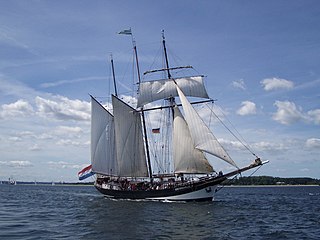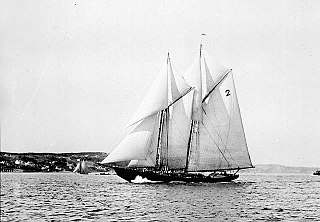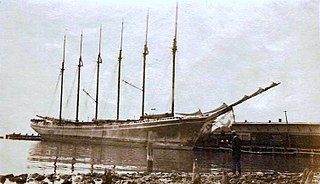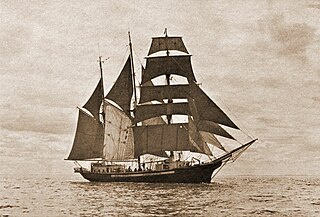
A schooner is a type of sailing vessel defined by its rig: fore-and-aft rigged on all of two or more masts and, in the case of a two-masted schooner, the foremast generally being shorter than the mainmast. A common variant, the topsail schooner also has a square topsail on the foremast, to which may be added a topgallant. Differing definitions leave uncertain whether the addition of a fore course would make such a vessel a brigantine. Many schooners are gaff-rigged, but other examples include Bermuda rig and the staysail schooner.

Bluenose was a fishing and racing gaff rig schooner built in 1921 in Lunenburg, Nova Scotia, Canada. A celebrated racing ship and fishing vessel, Bluenose under the command of Angus Walters, became a provincial icon for Nova Scotia and an important Canadian symbol in the 1930s, serving as a working vessel until she was wrecked in 1946. Nicknamed the "Queen of the North Atlantic", she was later commemorated by a replica, Bluenose II, built in 1963. The name Bluenose originated as a nickname for Nova Scotians from as early as the late 18th century.

Two Years Before the Mast is a memoir by the American author Richard Henry Dana Jr., published in 1840, having been written after a two-year sea voyage from Boston to California on a merchant ship starting in 1834. A film adaptation under the same name was released in 1946.
Several ships of the Royal Navy have been named Achilles, after the Greek hero Achilles. Four others, two of them prizes, had the French spelling of the name, Achille.

USS Threadfin (SS-410), a Balao-class submarine, was the only vessel of the United States Navy to be named for the threadfin.

A jackass-barque, sometimes spelled jackass bark, is a sailing ship with three masts, of which the foremast is square-rigged and the main is partially square-rigged and partially fore-and-aft rigged (course). The mizzen mast is fore-and-aft rigged.

Thomas W. Lawson was a seven-masted, steel-hulled schooner built for the Pacific trade, but used primarily to haul coal and oil along the East Coast of the United States. Named for copper baron Thomas W. Lawson, a Boston millionaire, stock-broker, book author, and president of the Boston Bay State Gas Co., she was launched in 1902 as the largest schooner and largest sailing vessel without an auxiliary engine ever built.

Wyoming was an American wooden six-masted schooner built and completed in 1909 by the firm of Percy & Small in Bath, Maine. With a length of 450 ft (140 m) from jib-boom tip to spanker boom tip, Wyoming was the largest known wooden ship ever built.

Gustaf Adolf Mauritz Erikson was a ship-owner from Mariehamn, in the Åland islands. He was famous for the fleet of windjammers he operated to the end of his life, mainly on the grain trade from Australia to Europe.

Rainbow Warrior was a three-masted schooner most notable for service with the environmental protection organization Greenpeace. She was built to replace the original Rainbow Warrior that the French intelligence service (DGSE) bombed in 1985 in the Port of Auckland, New Zealand, which sank the ship and killed photographer Fernando Pereira.
Eleven ships and a shore establishment of the Royal Navy have borne the name HMS Cormorant, after the seabird, the cormorant:

William Ion Belton Crealock was a yacht designer and author. He was one of the world's leading yacht designers from the 1960s through the 1990s, and his yachts were owned by the famous and wealthy, including Walter Cronkite and William Hurt.

The sailing ship Regina Maris was originally built as the three-masted topsail schooner Regina in 1908. She was a 144-foot (43.9-meter), wooden, completely fore-and-aft–rigged sailing ship with three masts. She was re-rigged in 1963 as a 148-foot (45.1-meter) barquentine. Regina Maris could reach a speed of up to 12 knots, especially on a half-wind course or with a fresh back-stay breeze.
Maid of England was a sailing barquentine built in Gross Coques, Digby County, Nova Scotia in 1919 by Omer Blinn. Maid of England was the last square-rigged cargo vessel built in Maritime provinces of Canada. Maid of England was owned by F.K. Warren for nine years, and then later abandoned at sea in 1928.

RV George Bligh (LO309) was a fisheries research vessel that was operated by the Directorate of Fisheries, now known as the Centre for Environment, Fisheries and Aquaculture Science (Cefas).

Dana was a four-masted motor schooner built for the Danish East Asiatic Company (EAK) and launched in 1919. It was made available to the Danish marine biologist Johannes Schmidt, who used it for two expeditions to the Sargasso Sea in 1920–1921. The main goal of the expeditions, named the first and second Dana expeditions, was searching for the spawning grounds of the European eel.

Dana was a Danish research vessel, best known for the circumnavigation of the world in the third Dana expedition 1928–1930.

Dana was the primary Danish research vessel for almost 40 years. It was built in 1937 and served research purposes until 1980. On the first cruise into the North Atlantic in 1938 it was discovered that the ship was unsuited for its purpose, as it was not sufficiently stable to allow scientific work. It was returned to the shipyard and extended by 8 metres (26 ft) in 1939. During the Second World War (1940-1945) the ship was kept and maintained in Copenhagen harbour, but with vital engine parts removed and thus never seized by the German occupation force.
This page is based on this
Wikipedia article Text is available under the
CC BY-SA 4.0 license; additional terms may apply.
Images, videos and audio are available under their respective licenses.














